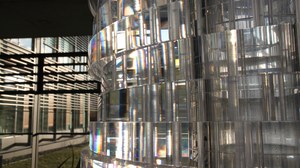Convergence: Real meets Digital
At the Institut für Bauinformatik we investigate and develop new methods and tools to boost the digitalzation of the AECO-sector (Architecture, Engineering, Construction, and Operation). This includes methods used in data engineering and artificial intelligence and their application in BIM, building automation, robotics or parametric design. Complementing to these developments we explore the interplay between business process management, new technologies and new work spaces with an emphasis on our discipline.
Influenced by researchers from Carnegie Mellon University and Stanford's CIFE we developed a tradition of 'Living Laboratories', i.e. we use our own or partners facilities as 'Demonstrators' for our research.
Seamless, holistic Information Sharing
For about 400 years humans try to replace labour-intensive, repetetive calculations by some form of 'support tools'. One of the first mentions is a letter sent by Wilhelm Schickard to Johannes Keppler in 1623. Approximately 300 years later the German Civil Engineer Konrad Zuse developed one of the first freely programmable electrical computers. Additionally, Zuse presented one of the first programming languages back in 1945.
Now, in the beginning of the 21st century, we talk about the 'Internet of Things', i.e. our daily life is penetrated by computer technology 24/7. However, new challenges arise for which researcher and engineers must find appropriate reponses and practical solutions.
The city of Dresden, including TU Dresden, is and always was an international renowed centre for the development of computers. Graduates from TU Dresden paved the way for establishment of 'Bauinformatik' as a new resarch discipline in both parts of the than divided Germany.
Currently, our research addresses the following challenges:
- What are manageble structures for large-scale digital 'building' models?
- What determines the quality of digital models?
- What synergy effects can be exploited from the creation of integrated, holistic, life-cycle oriented building models?
- How can we achieve a completely new 'technology chain', i.e. integrating digital design (BIM) with digital manufacturing (robotics) and digital operation (Smart Cities)?
- What risks originate from information sharing across stakeholders from different disciplines and how can we address them?
- What must be done to preserve digital information (with optimal cost) over the whole building life-cycle?


